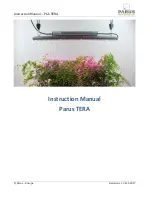
13
3. INSTALLATION
3.1 Unpacking the centrifuge
Open the package carefully taking care not to damage the machine inside. Take the centrifuge
out of the box and ensure that all accessories are checked and identified.
Keep packaging materials at hand for possible transport in the future.
3.2 Location
Almost all the energy supplied to the centrifuge is transformed into heat and then emitted to the
environment. Therefore, proper ventilation is essential, and ventilation ducts must be kept clear
at all times. Moreover, the centrifuge should not be located near any heat source such as
radiators and should be kept away from direct sunlight. The bench that the centrifuge sits on
should be stable and flat. Around the centrifuge, a 300mm radius safety zone must be
established. The normal laboratory operating conditions are from 15
C to 35
C. In the case of
changing machine location from extreme cold to warmer conditions, please allow the centrifuge
to stand with the lid open for a minimum of 4 hours.
This will reduce any chance of condensation taking place in side the centrifuge.
3.3 Connection to the power supply
Supply voltage has to be consistent with that given on the rating plate. MSE centrifuges come
with a 2-metre long IEC lead fitted with plugs resistant to the dynamic loadings.
MSE recommends that an emergency cut -out should be installed far away from the centrifuge,
near the exit door from the room or outside the room. Supply voltage should be either 230 V
50/60 Hz, or 110/220 V 50/60 Hz.
3.4 Fuses
The centrifuge has standard protection with the WTA-T 3.15 Amp 250 V fuse, which is situated
in the IEC socket at the back of the centrifuge. The fuse fitted in the plug of the IEC lead is 5A.










































